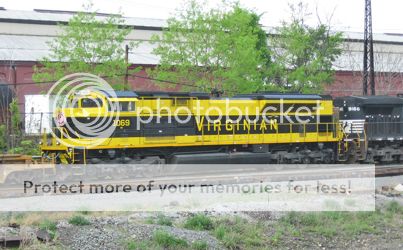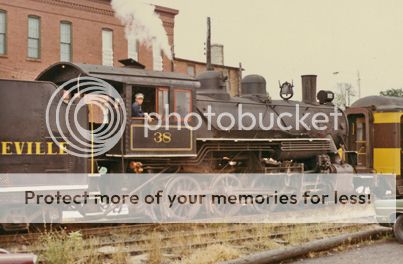 Here it comes! (Photo by Bobbalew.) —Another FABULOUS shot!
Here it comes! (Photo by Bobbalew.) —Another FABULOUS shot!At least to me it is.
Last month’s was
fabulous too.
The November 2014 entry of
my own calendar is a westbound mixed up Three passing an empty eastbound slab-train down One at Brickyard Crossing.
I usually don’t do well at Brickyard.
Brickyard Crossing is where Porta Road crosses the old Pennsy main, now operated by Norfolk Southern.
Brickyard Crossing is the only grade-crossing in Altoony. It doesn’t get much traffic, so wasn’t bridged.
There used to be a brickyard adjacent, but now it’s gone. Railfans and the railroad still call it “Brickyard Crossing.”
It’s a great place to watch trains, but not to photograph ‘em.
Northeast of the crossing is an embankment that overlooks the tracks. It’s okay in late afternoon, or if it’s cloudy, but in mornings trains are
too backlit.So go back across to the southeast side of the tracks. But that’s below the railroad-grade, which always looks
wonky.The grade-crossing also has crossbucks, flashing lights, and gates.
I’ve tried to use ‘em as a foreground, but it never works.
But this time it was cloudy, I was propped against the crossbucks-pole, and I was using a lot of telephoto.
An empty slab-train came down Track One. It’s all gondola-cars, used to transport heavy steel slabs to a rolling-mill.
Two slabs per car, one slab at each end.
The train is empty, going back for another load of slabs.
Yet
here came a westbound, up Track Three.
Strong telephoto (I wasn’t maxxed, which is 300 mm) takes out distraction. It’s kind of what your eye sees.
What makes this picture
extraordinary is the slab-train on One.
I’ve taken similar pictures, but if it’s only one train, it’s
dull.I tend to avoid Brickyard, since it’s usually a
lousy shot.Whether I went there or not would depend on conditions.
This picture is
cloudy, and I could use a sunny shot.
But that’s late afternoon.
I’ll never forget the first time my brother-from-Boston saw Brickyard. I had to pull teeth to get him to go there.
Railfan overload; at least two trains at once; maybe three — I don’t remember.
And they are
right in your face!He was was glad I took him, but it’s not a good place to photograph.
 Corsair! (Photo by Philip Makanna©.)
Corsair! (Photo by Philip Makanna©.)—The most recognizable shape in aviation, the inverted gull-wing Chance-Vought F4U Corsair.
The November 2014 entry of my
Ghosts WWII warbirds calendar is an F4U Corsair.
And it’s the four-bladed propeller, which signifies the 2,300 horsepower
Pratt & Whitney R-2800 Double-Wasp engine, 2,800 cubic-inches.
A two-row air-cooled radial engine of 18 cylinders.
My
WWII warbirds site doesn’t cover all iterations of the Corsair. It gives a rating of 2,000 horsepower. That’s the three-bladed propeller, the first Corsairs.
The Corsair is a fairly large airplane, compared to the
P-51 Mustang.
They had to be built strong-enough to withstand being slam-landed on an aircraft-carrier deck.
I don’t know if a P-51 could stand that. It’s a smaller airplane of 1,695 horsepower.
The Corsair has that inverted gull-wing because of its
gigantic 14-foot propeller.
They could reduce the size of the propeller, lengthen the landing-gear, or do what they did: give it an inverted gull-wing, which raised the airplane high enough on its landing-gear to clear that propeller.
Japanese fighter-pilots called the Corsair “whistling-death.” The Corsair apparently emitted a whistling sound.
So far all the Corsairs I’ve seen, and I’ve seen quite a few, are the three-bladed propeller. I’ve yet to see four-bladed.
Many years ago, back in 1951, I made a field-trip with my Cub-Scout troop to Willow Grove Naval Air Station north of Philadelphia. —I would have been seven.
A Navy fighter-jock strode cockily out to his Corsair, and fired it up.
I will never forget it.A giant plume of yellow flame gushed out the exhausts, and down the flanks of the Corsair.
“Won’t it catch fire?” I asked worriedly.
“No!” exclaimed our guide, laughing.
Soon the Corsair was roaring over our heads to practice tailhook landings on the runway.
A tailhook-landing is how they do it on aircraft-carriers.
A cable is stretched across the carrier-deck, and a tailhook on the plane snags the cable, which keeps the plane from sailing off into the sea.
A cable had been stretched across the runway, just like an aircraft-carrier.
 Heritage-unit! (Photo by Jason Eddy.)
Heritage-unit! (Photo by Jason Eddy.)The November 2014 entry of my
Norfolk Southern Employees’ Photography-Contest calendar is a stacker being led by #1069, the Virginian Heritage-Unit.
It’s an
EMD SD70-ACe; meaning it has AC traction-motors.
Norfolk Southern had 20 of its new diesel locomotives painted in paint-schemes of predecessor railroads.
Virginian Railway was merged into competitor Norfolk & Western back in 1959. Norfolk Southern is a merger of Norfolk & Western and Southern Railway back in 1982.
#1069 is the
BEST-looking Heritage-Unit. The Heritage-Units get used all over the railroad in regular service.
 |
| The Pennsy Heritage-Unit. (Photo by Mike Kimmel©.) |
 |
| The DL&W Heritage-Unit. (Photo by Mike Castellow©.) |
 |
| The NYC Heritage-Unit. (Photo by Mike Kimmel©) |
Others are #8102, painted in Pennsy colors, and #1074, painted as Delaware, Lackawanna & Western.
Another is #1065, painted in New York Central’s lighting-stripe scheme.
I’ve seen 8102, but not 1065 or 1074.
Seeing a Heritage-Unit is fairly likely.
I’ll never forget the first time we saw 1069. My brother and I were chasing
765, the restored Nickel Plate steam-locomotive.
We were in Altoona, and an eastbound pulled in and stopped.
 |
| #1069. (Photo by Jack Hughes.) |
1069 was the last locomotive in the consist.
“What’s this?” I said. “Virginian no longer exists.”
My brother thought it was a Virginian locomotive.
“It’s one of those Heritage-Units,” I exclaimed.
And in my humble opinion, #1069 is the best-looking of all 20. 8102 and 1065 look pretty good, but not as good as 1069.
#1069 is leading a southbound stacker on the newly refurbished Crescent Corridor through Spencer, NC.
 The California-Kid without flames. (Photo by Scott Williamson.) —Normally I don’t think much of ’34 Ford hotrods.
The California-Kid without flames. (Photo by Scott Williamson.) —Normally I don’t think much of ’34 Ford hotrods.But this car looks pretty good.
The November 2014 entry of my
Oxman Hotrod Calendar is a ’34 Ford three-window coupe hotrod.
It’s very tastefully done, although normally I prefer the ’32.
The car’s owner was inspired by “The California-Kid,” also a ’34.
 |
| “The California-Kid.” |
But that car has flame-paint, and this calendar-car doesn’t.
To me, flame-paint looks
silly. It can detract from the beauty of the car.
Fortunately this car’s owner didn’t do anything
stupid. No flames, and the fenders are still there.
About all the guy did is chop the top: three inches in back, and three-and-a-half in front.
The body is a fiberglass reproduction, but the fenders and running-boards are original, as is the frame.
That snarling radiator-grille is also original, and the headlights are from an early Ford truck.
The car has a ’66 289 Ford Cobra V8, topped by an Edelbrock manifold and carburetor — that is, it sounds
driveable.Although you probably hafta be careful to not bottom it, since it looks fairly low.
It’s a great-looking hotrod, but I still prefer the ’32.
 Look at that ’41 Chevy! (Photo by William W. Rinn©.)
Look at that ’41 Chevy! (Photo by William W. Rinn©.)—You probably hardly see it in a blog-picture, but that car next to the train is a ’41 Chevy.
The November 2014 entry of my
Audio-Visual Designs black-and-white All-Pennsy Calendar is Pennsy’s
Fort Pitt passenger-train from Chicago east to Pittsburgh speeding over Pennsy’s Fort Wayne racetrack in northern Indiana.
The train is pulled by a brace of two Erie-built Fairbanks-Morse A-units, purchased first as freight-locomotives, but then regeared for passenger-service.
I know as a railfan I’m supposed to look at that train, but the first thing I noticed was that ’41 Chevy on the parallel highway.
As I understand it, the ’41 Chevy was one of the most popular used-cars
of all time. Others were the ’57 and the ’64.
Our family had a ’41 Chevy; we had it in the early ‘50s.
A ’41 Chevy in the early ‘50s is a bit of a stretch, but it was a very nice car, at least in appearance.
We bought it from a family in our church, who thought the world of it, and babied it.
It had a visor and spotlight, owner-installed add-ons.
It wasn’t a typical four-door sedan of six side-windows, as pictured, a small window behind the rear door.
It was four doors, but only four side-windows; I think a “custom.” I think all GM brands had “customs.”
Transferring a babied car to my father was like consigning it to
the pits of Hell.My father never maintained any of his automobiles. —Unless they didn’t start or run.
Death to my father’s cars was -a) if they blew up, or -b) if they failed inspection.
Some of my father’s cars were junked, but I think the ’41 made it to a hot-rodder.
The ’41 looked nice, but I don’t think its previous owner did maintenance. Oil maybe, but it overheated on the Pennsylvania Turnpike near Pittsburgh.
My father, ignorant of car-maintenance, removed the thermostat — a bad move — and replaced the gasket with a cut-out from a Ritz cracker-box.
The radiator was probably later boiled out, the thermostat reinstalled with a proper gasket, and we continued without incident all the way to Arkansas — from south Jersey.
My sister always says “Name one car that didn’t break down on the first day of a vacation-trip.”
Well, there was one, our ’53 Chevy, otherwise known as “the Blue-Bomb,” that went all the way to St. Paul and back without breakdown in 1960. (It was navy-blue.)
My father parked it illegally in a church parking-lot, declaring “The Lord will watch over it,” while we took the train up into Canada for over a week.
I’m not making this up, dear readers. My father was a Bible-beating zealot.
The ’53 Chevy was the car I learned to drive in.
Our tires were always cast-off baldies picked up at a junkyard. He repaired exhaust-systems with Campbell soup-cans from our trash.
When I pointed out bald tires before a long journey from Rochester home to northern Delaware, I was angrily told the Lord would protect them.
My mother was always incensed with my father’s cars, but he refused to buy dependable transportation or maintain what he had.
It cost too much!Pennsy dieselized
late, and needed so many locomotives
Electromotive Division of General Motors, the most reliable diesels, could not fill Pennsy’s demand.
Pennsy had to buy from other diesel-locomotive manufacturers, like Alco, Fairbanks-Morse, and even Baldwin.
Baldwin’s early diesels were
worst. They’d break down and cripple out on the railroad, which clogs the railroad.
A crippled train has to be rescued. You can’t just drive around a crippled train — you need the railroad.
So Pennsy paid the price for late dieselization: locomotives prone to breakdown.
I guess Fairbanks-Morse locomotives weren’t too bad. But you no longer see Fairbanks-Morse in the locomotive market.
In fact, Alco is gone too, and they were pretty good. They were using General Electric traction-motors, then tanked when GE ended the contract and brought out a locomotive of their own.
Now GE just about owns the locomotive market, and EMD plays second-fiddle — but a very strong second-fiddle.
Seeing this picture I have to remember this is the world I was born into. The picture was taken in 1949, when I would have been five.
So a ’41 Chevy is not extraordinary. In fact, it’s predictable.
But at 50 mph that ’41 Chevy was passed by the
Fort Pitt, which was probably doing over 60 mph — maybe as much as 80.
 Overkill. (Photo by Peter Harholdt©.)
Overkill. (Photo by Peter Harholdt©.)—The November 2014 entry in my
Motorbooks Musclecar calendar is a COPO 9561 427 1969 Camaro.
Ahem, this car has been in this calendar
before, February of 2012.
COPO stands for Central-Office-Production-Order, the system Chevrolet had for accommodating fleet buyers of specially-optioned cars, usually taxicabs, police, or gumint.
Yet Don Yenko, a performance-oriented Chevrolet dealer in PA, was slipping Big-Block Chevrolet engines into the Camaro.
Chevrolet’s top performance-option for the Camaro was the Big-Block 396, yet apparently a 427 cubic-inch version of this motor was available for full-size Chevrolets and Corvettes.
Yenko wanted to put this engine in a Camaro. Supposedly such a combination would
spank a 396-Camaro.
Yenko was responsible for some extraordinary cars, for example the “Yenko Stinger,” a souped up Corvair.
 |
| Yenko’s Stinger. |
So he proposed Chevrolet make a 427-Camaro as a COPO special-order.
Soon other Chevrolet dealers could order the same car.
COPO 9561 was a
sleeper. You’d never know it had that killer motor.
Such a combination would be
just about unbeatable in a straight line, assuming you could get the lightly-loaded drive-tires to not melt in a cloud of smoke.
But you dare not hurl it into a corner. With all that weight on the front-end, a 427-Camaro would plow into the weeds.
A Camaro could handle quite well, assuming you didn’t have a
gigantic heavy motor over its front-end.
The best Camaro was the Z/28, the option for Trans-Am racing.
A powerful SmallBlock of only 302 cubic-inches powered a Z/28.
Such a combination, being lighter, was less likely to plow in a corner.
In fact, race-driver Mark Donohue won the Trans-Am through 1969. His car was a Z/28 entered by Roger Penske (“penn-ski”),
 |
| The 1969 Penske/Donohue Z/28. |
But it wasn’t exactly stock. It was a Z/28
heavily finessed. The stock Z-28s weren’t as good a Donohue’s Camaro.
Given a choice between a Z/28 and one of these COPO 9561 Camaros, I’d take the Z/28.
I ain’t interested in goin’ off the road.
Essentially a COPO 9561 can only be drag-raced.
And it looks like photographer Harholdt is burning out.
As mentioned earlier, this calendar-entry is a repeat.
I managed to buy another Motorbooks Musclecar Calendar, but it’s not Harholdt.
Which is a shame, since my new calendar is
overdone. Harholdt was just simple illustration.
 There’s a smokestack growing out of that Geep. (Photo by Mark Smetco.) —Boobie-prize!
There’s a smokestack growing out of that Geep. (Photo by Mark Smetco.) —Boobie-prize!The November 2014 entry in my
All-Pennsy color calendar makes one of the most
grievous errors a photographer can make: it has a smokestack growing out of the subject.
I’d like to think the photographer was aware.
But he shot anyway,
it’s a train, dude!I considered cloning out that smokestack with my Photoshop — that is, clone sky over the smokestack.
But I didn’t. It would have been
messy, and obvious. The sky is of varying intensity.
I also surmise the publishers of this calendar don’t have much to work with. Color photography from back then is not that available.
Plus so far there haven’t been many diesels, no freight diesels at all.
The picture is three Pennsy diesels leading a coal-train in 1967 through Oroville, Ohio.
And for sticklers, that third unit is Detroit, Toledo & Ironton, but it’s leased by Pennsy.
All the units are
EMD GP-9s, but the second unit is
cabless.Pennsy had over a hundred GP-9s, and at least one is left, #7048 at
Horseshoe Curve.
 |
| #7048 is at left. (Photo by Bobbalew.) |
#7048 lasted into the Conrail era, but is now just on display.
It replaced a Pennsy K-4 Pacific (4-6-2).
It’s easy to make the mistake; telephone-poles, water-towers, fire-hydrants. Your eye sees only your subject, but your camera
sees everything.I also have lots of pictures with foreign power, but it’s usually just shared run-through, not leased.
Labels: Monthly Calendar Report


















































